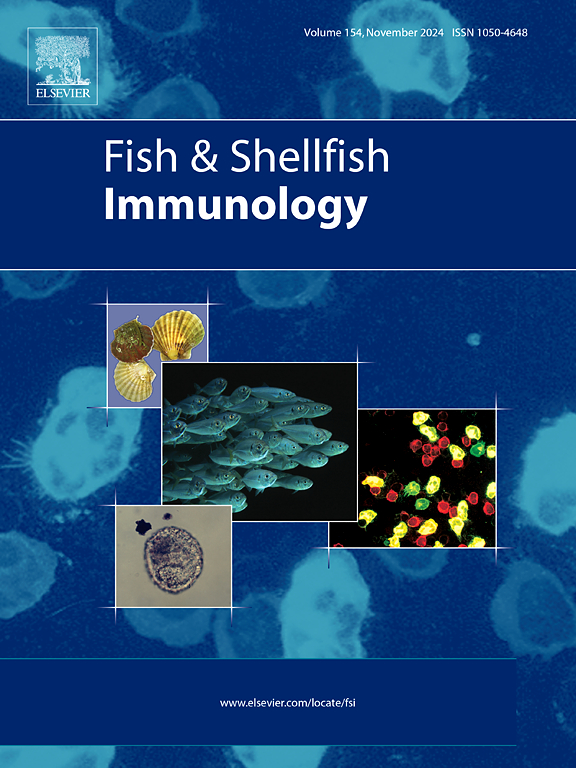ILA mitigates HFD-induced metabolic dysfunction via lipid-immune crosstalk and gut microbiota modulation in zebrafish
IF 3.9
2区 农林科学
Q1 FISHERIES
引用次数: 0
Abstract
High-fat-induced metabolic syndrome poses many challenges to fish farming. In our previous study, we found that probiotic Akkermansia muciniphila can increase the tryptophan microbiota metabolite indole-3-lactic acid (ILA). Therefore, this study further investigates the effect of ILA on resisting HFD-induced metabolic disorders and preliminarily explores its mechanism in zebrafish. We found that supplementation with 100 μg/g ILA significantly attenuated HFD-induced weight gain, improved feed conversion ratio, and had no effect on survival rate. Additionally, ILA alleviated hepatic steatosis, significantly reducing triglyceride accumulation by downregulating lipogenic genes (DGAT2, SREBP-1c; p < 0.01, p < 0.05), while enhancing the expression of lipolytic gene, such as UCP2 (p < 0.01). Concurrently, ILA preserved intestinal barrier integrity by attenuating intestinal villi damage and restoring tight junction ultrastructure. qRT-PCR results showed that ILA supplementation enhanced both intestinal mechanical and chemical barrier integrity by upregulating tight junction proteins (Muc2, TJP-1α, Cldn12) and complement C3b. Additionally, HFD increased serum LPS and hepatic LBP, which were reversed by ILA. And it could also ameliorate HFD-induced low-grade inflammation, as evidenced by suppressing pro-inflammatory cytokines (TNF-α, IL-6; p < 0.05) while elevating anti-inflammatory IL-10 (p < 0.05). Gut microbiota analysis revealed ILA intake exerted no significant effects on alpha diversity, yet profoundly restructured microbial composition by reducing Bacillota, Bacteroidota abundance and enriching Fusobacteriota, Verrucomicrobiota compared to the HFD group, accompanied by reduced abundance of pathogenic genera (Shewanella, Acinetobacter, Malacoplasma, Culicoidibacter, and Pseudomonas). Transcriptome sequencing analysis identified 3594 differentially expressed genes (DEGs) following ILA supplementation. These DEGs were significantly enriched in lipid metabolism and immune-related pathways, including drug metabolism-cytochrome P450, steroid hormone biosynthesis, fatty acid degradation, glycerolipid metabolism, as well as the PPAR/FoxO/insulin signaling pathways. It was further verified that the effects of ILA could be mediated via AhR2 receptor activation, followed by the modulation of Cyp1a1, a downstream gene involved in drug metabolism-cytochrome P450. Multi-omics analyses revealed significant correlation between gut microbial genera abundance and pathway-specific gene expression. These findings collectively demonstrated that ILA ameliorates HFD-induced metabolic dysfunction through dual regulation of lipid homeostasis, intestinal barrier function, and inflammation, providing insights into its potential mechanisms.
ILA通过脂质免疫串扰和肠道菌群调节减轻hfd诱导的斑马鱼代谢功能障碍
高脂肪代谢综合征给养鱼带来了许多挑战。在我们之前的研究中,我们发现益生菌Akkermansia muciniphila可以增加色氨酸微生物代谢产物吲哚-3-乳酸(ILA)。因此,本研究进一步研究了ILA在抵抗hfd诱导的斑马鱼代谢紊乱中的作用,并初步探讨了其在斑马鱼中的作用机制。我们发现,添加100 μg/g ILA可显著降低饲料食液诱导的增重,提高饲料系数,但对成活率无影响。此外,ILA减轻了肝脏脂肪变性,通过下调脂质基因(DGAT2, SREBP-1c; p < 0.01, p < 0.05)显著降低甘油三酯的积累,同时增强了脂质基因UCP2的表达(p < 0.01)。同时,ILA通过减轻肠绒毛损伤和恢复紧密连接的超微结构来保持肠屏障的完整性。qRT-PCR结果显示,ILA通过上调紧密连接蛋白(Muc2、TJP-1α、Cldn12)和补体C3b,增强了肠道机械和化学屏障的完整性。此外,HFD增加了血清LPS和肝脏LBP,这被ILA逆转。它还可以改善hfd诱导的低度炎症,如抑制促炎细胞因子(TNF-α, IL-6; p < 0.05),升高抗炎IL-10 (p < 0.05)。肠道菌群分析显示,与HFD组相比,摄入ILA对α多样性没有显著影响,但却深刻地重构了微生物组成,减少了Bacillota、Bacteroidota的丰度,增加了Fusobacteriota、Verrucomicrobiota,同时致病属(Shewanella、Acinetobacter、Malacoplasma、culicoidibacterter和Pseudomonas)的丰度。转录组测序分析鉴定了3594个差异表达基因(DEGs)。这些deg在脂质代谢和免疫相关途径中显著富集,包括药物代谢-细胞色素P450,类固醇激素生物合成,脂肪酸降解,甘油脂代谢以及PPAR/FoxO/胰岛素信号通路。进一步证实了ILA的作用可能通过AhR2受体激活,随后调节下游参与药物代谢的基因Cyp1a1 -细胞色素P450介导。多组学分析显示,肠道微生物属丰度与途径特异性基因表达之间存在显著相关性。这些发现共同表明,ILA通过脂质稳态、肠道屏障功能和炎症的双重调节,改善了hfd诱导的代谢功能障碍,为其潜在机制提供了新的思路。
本文章由计算机程序翻译,如有差异,请以英文原文为准。
求助全文
约1分钟内获得全文
求助全文
来源期刊

Fish & shellfish immunology
农林科学-海洋与淡水生物学
CiteScore
7.50
自引率
19.10%
发文量
750
审稿时长
68 days
期刊介绍:
Fish and Shellfish Immunology rapidly publishes high-quality, peer-refereed contributions in the expanding fields of fish and shellfish immunology. It presents studies on the basic mechanisms of both the specific and non-specific defense systems, the cells, tissues, and humoral factors involved, their dependence on environmental and intrinsic factors, response to pathogens, response to vaccination, and applied studies on the development of specific vaccines for use in the aquaculture industry.
 求助内容:
求助内容: 应助结果提醒方式:
应助结果提醒方式:


